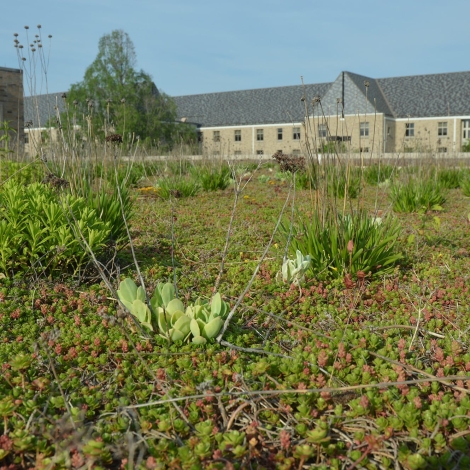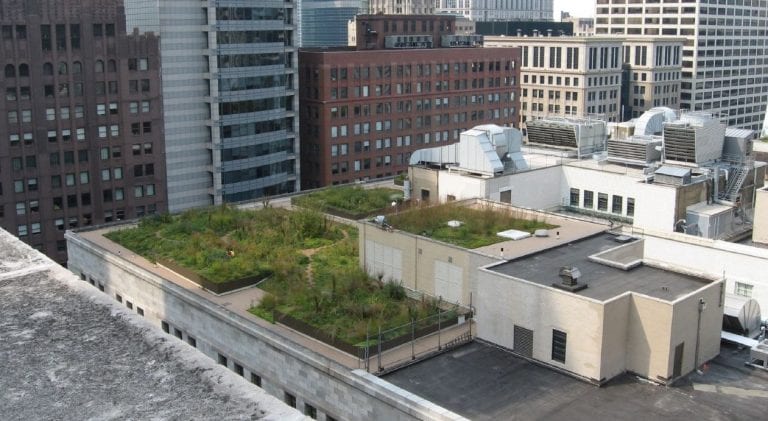Heat waves aren’t just a source of discomfort. They’re the nation’s deadliest weather hazard, accounting for a fifth of all deaths caused by natural hazards in the U.S.
Most of the time, low-income people who live in cities face the biggest risks tied to extreme heat. That’s because urban areas, especially neighborhoods with few parks or yards, absorb high amounts of solar radiation during the day – keeping night temperatures higher than in suburbs and rural areas.
I’m an atmospheric scientist who studies urban environments in an interdisciplinary way that combines science, engineering and social sciences. I belong to a team of researchers and other professionals that’s looking into one solution we believe will help cool off homes, businesses and other structures all summer long: green roofs.
Urban ecosystems
Green infrastructure encompasses a range of methods to manage weather impacts, providing many community benefits in cost-effective ways.
For example, using permeable pavement, planting and preserving trees and other green spaces, establishing vertical gardens on a building’s exterior and making rooftops white can all help moderate urban temperatures, cut utility bills and make neighborhoods nicer places to live.
Many cities are also experimenting with green roofs, rooftops that are partially or completely covered in drought-resistant plants with drainage and leak detection systems, to see if they can cool off urban heat.
These roofs can serve as a source of insulation or shade, cut electricity consumption, add green space and reduce air pollution. However, bunching too many of them together in large areas could actually reduce air quality by increasing humidity and pollution.
I led a recent study that used an interdisciplinary approach to see where it would make the most sense to install green roofs to cool off homes in hot neighborhoods. As we explained in the journal Environmental Research Letters, we identified Chicago’s most vulnerable, heat-stressed neighborhoods – the communities that would benefit most from this amenity.
Straining utilities and burdening the poor
When temperature spike in cities, electricity use rises sharply making it hard for utilities susceptible to power outages. When the lights go out, critical services such as drinking water, transportation and health care can be jeopardized. And poorer people, whose neighborhoods tend to be the hottest, can be the most at risk.
Some of the poorest Americans, of course, do not even have air conditioning. In other cases, they may have it installed but face so much economic hardship that they can’t afford to use it.
Chicago is most vulnerable to outages in July, when temperatures tend to peak. Electricity usage gets nearly as high in December due to the widespread use of Christmas lights throughout the holiday season, the electric heat consumed by 20 percent of local residents and the incidence of many of the year’s longest nights.
Green roofs can help avoid outages by lowering rooftop surface temperatures. In turn, residents may consume less air conditioning and ease the strain on the grid when it matters most. But how green roofs should be deployed to maximize these benefits remains an open question.
Where to invest
My team identified neighborhoods that had the most to gain from green roofs by figuring out which neighborhoods had the most heat vulnerability, and the greatest potential reductions in rooftop temperatures with green roofs, and used the most electricity for air conditioning.
People who reside in poor vulnerable neighborhoods consistently use relatively little air conditioning. However, businesses located in vulnerable neighborhoods do use more energy than enterprises located in more affluent areas because temperatures tend to get and stay higher in poorer neighborhoods, requiring more energy to cool down interiors.
We designed steps for urban planners and city officials to scientifically set priorities for a public effort to install green roofs, neighborhood by neighborhood.
Most of the communities we determined would get the biggest benefits from green roofs are located on Chicago’s South Side and West Side. Given that between 1986 and 2015, an average of 130 people lost their lives across U.S. every year due to heat stress, for many of these residents it could be a matter of life and death.
About the Author
Ashish Sharma is a Research Assistant Professor at the University of Notre Dame.
This article was originally published on The Conversation. Read the original.


Beautiful article. Good job